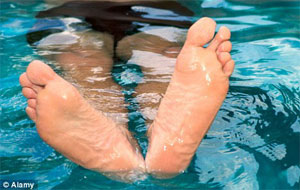|
정말 그럴까.
사실이 아닌(be simply not true) 신체와 건강에 대한 이런 것들을 매일 듣거나 읽게(every day hear or read things about your body and health) 된다. 많은 경우에 있어서(in many cases) 과학적으로 인정되지 못한(be scientifically discredited) 것들이다.
그럼에도 불구하고 아직도(yet still) 수 많은 사람들은 이런 의학적 미신들(these medical myths)을 신봉하고 있다. 심지어 어떤 의사들은 이들 중 일부을 사실이라고 믿고(believe some of them) 있다.
두 명의 손꼽히는 소아과 의사들(two leading pediatiricians)이 많은 통념적 건강 주문(呪文)들에 대한 증거를 조사해(examine the evidence for many common health mantras) 본 뒤 새 책을 통해 일부 뜻 밖의 새 사실들(some surprising revelations)을 공개했다.
남자들은 7초마다 섹스에 대한 생각을 한다?
남자들이 섹스에 대해 많은 생각을 한다는(think about sex a lot) 것은 용인된 사실처럼 받아들여져(become an accepted truth) 왔다. 어떤 버젼으로 들었느냐에 따라(depending on which version you‘ ve heard) 수 분마다 또는 7초마다가 될 수(could be every few minutes or every seven seconds) 있다. 언뜻 보기에도(on the face of it) 우스꽝스러운(be ludicrous) 소리다.
평균적인 남성이 하루에 16시간 깨어있다고 가정할(assume that an average male is awake for 16 hours a day) 때 하루에 8000번 이상 섹스에 대해 생각해야 한다는(would have to think about sex more than 8000 times a day) 얘기다. 사람이 깨어있는 동안 숨쉬는 것과 대략 비슷한 횟수다(be about as many times as a person breathes while awake).
성욕에 대한 역대 조사들 중 가장 포괄적인 것(the most comprehensive survey ever completed on sexuality)인 ’성욕의 사회적 구조: 미국 내의 성행위‘ (The Social Organization of Sexuality: Sexual Practices in the United States)에 따르면 남성의 54%는 매일 한 차례 또는 수 차례 섹스에 대해 생각하며(think about sex every day or several times a day), 43%는 한 달에 수 차례 또는 일주일에 수 차례(a few times a month or a few times a week)만 생각하는 것으로 나타났다. 심지어 남성들의 4%는 한 달에 채 한 차례도(less than once a month) 섹스에 대해 생각하지 않는 것으로 집계됐다.
여성들은 똑같은 질문이 주어졌을 때(when asked the same question) 19%가 매일 또는 하루에 여러 차례 생각한다고 답했으며, 67%는 한 달에 수 차례 또는 일주일에 수 차례 생각한다고 밝혔다. 한 달에 채 한 차례도 생각하지 않는다는 여성은 14%였다.
다시 말해 여성들은 남성들보다 섹스에 대한 생각을 덜하는(think about sex less than men) 것은 사실이지만 그 차이는 남성들과 큰 차이가 없다는(be not as great as men think) 얘기다.
사람은 뇌의 10%만 사용할(use only 10 per cent of the brain) 뿐이다?
사람들은 100년 넘게 이 같은 얘기를 사실로 믿어왔다(have believed this for more than 100 years). 말인즉 불행히도 100년 넘게 잘못 생각해왔다는 것이다.
CT 스캔, MRI 스캔 및 훨씬 더 세밀한 기술을 포함한 여러 유형의 두뇌 화상들(different types of brain-imaging, including CT scans, MRI scans and evern more detailed techniques)을 살펴보면 뇌의 어느 부분도 완전히 침묵하거나 비활동적으로 있지는(be completely silent or inactive) 않는다.
뇌의 10%보다 훨씬 많은 부분(much more than 10 per cent of the brain)이 대부분의 시간 동안 바쁘게 움직인다(be busy at work most of the time). 사실상 뇌의 100%를 사용하고 있는 셈이다.
밤 늦게 음식을 먹는 것(eating late at night)이 살찌게 한다?
|
그 이론적 근거(the morale)는 저녁 늦게 또는 잠자리에 들기 전에 먹으면(eat later in the evening or before you go to bed) 잠들기 전에(before you fall asleep) 그 열량들을 소모할 시간을 못 갖는다는(won’ t have time to burn off those calories) 데 있는 듯 하다. 아니면 신진대사가 저녁 때는 떨어진다는(metabolism slows down in the evening) 것을 근거로 하는 것 같다.
그러나 여러 연구 결과들은 문제가 되는 것은 어느 시간대가 아니라(be not the time of day that matters) 얼마나 먹느냐는(how much you eat) 것임을 보여주고 있다. 한 예로(for instance) 86명의 비만 남성과 61명의 평균 남성들을 상대로 한 스웨덴의 한 연구(one Swedish study of 86 obese men and 61 average-weight men) 결과에 따르면 그들이 먹는 시간대에는 차이가 없는(find no difference in the timing of when they eat) 것으로 나타났다.
또 각급 체중의 2500여명 환자들을 대상으로 한 연구에선(in a study of more than 2500 patients of all weights) 먹는 시간대(the time of day that they eat)는 체중 증가 여부와는 아무런 관련이 없는(have nothing to do with whether or not they gain weight) 것으로 조사됐다.
하루에 세 끼 이상 먹는 것(eating more than three meals per day)이 비만 요인이 되는(play a role in obesity) 것으로 나타났다. 체중 감량과 건강한 체중 유지의 요건(the key to weight loss or to maintaining a healthy weight)은 매우 간단하다. 신체가 소모하는 것보다 적은 칼로리를 섭취하는(eat fewer calories than your body burns) 것 뿐이다.
소변은 투명해야 한다(urine should be clear)?
소변은 옅은 황색이거나 거의 투명해야(be pale yellow or almost clear) 한다고 믿는 사람들이 많다. 소변 색깔이 짙으면 탈수현상임이 분명하므로(must be dyhydrated) 물이 더 필요하다(need more water)고 여긴다. 물을 하루에 약 6~8잔(about six to eight glasses of water a day)은 마셔야 한다고 믿는다. 과연 그럴까.
주어진 양의 소변 속에(in a given volume of urine) 더 많은 것이 녹아있을 경우 소변은 농축된다(be more concentrated). 따라서 짙어보이는(look darker) 것이다. 하지만 정상적인 소변의 삼투질농도(the osmolality of normal urine)는 사람마다 다를(vary from person to person) 수 있다.
대부분의 경우(most of the time) 건강하고 충분한 수분 섭취를 한 사람의 정상적 소변(normal urine from a healthy, well-hydrated person)도 아주 노란색일 수(may be very yellow) 있다. 그걸 투명하거나 옅은 노란색으로 만들려고 애를 쓰고(struggle to get it clear or pale yellow) 있다면, 공연한 걱정을 하고 있는(be worrying for nothing) 것이다.
이러한 소변색깔 건을 무시해버리는 데는 한 가지 보류사항이 있다(there is one caveat to dismissing this urine-color business). 의사가 재발성 신장 결석과 같은 의학적 질병 때문에(because of a medical condition such as recurrent kidney stones) 당신에게 소변을 정상적인 것보다 더 옅게 만들라고 권고한다면(recommend getting your urine lighter than normal) 그 때는 의사들이 권하는대로 하는(do as the doctors advise) 것이 좋다.
발 큰 남자는 그 것도?
|
어떤 이들은 남성의 음경 크기를 발 크기로 알 수 있다고 주장(claim a man‘ s penis size canbe predicted by the size of his feet)하고, 다른 어떤 이들은 진짜 그 비밀을 알려주는(give away the secret) 것은 손 또는 심지어 코의 크기(the size of his hands or even his nose)라고 말하는 사람도 있다.
신체 부위를 비교해보는 생각(the idea of comparing body parts)은 실제 과학에 뿌리를 두고 있는 것일 수(may have its roots in real science) 있다. 포유류의 호메오 박스 유전자(the Hox gene in mamals)는 음경과 클리토리스 뿐 아니라 발가락과 손가락의 발달에도 역할을 한다(play a role in the development of the toes and fingers as well as the penis or clitoris).
그러나 이러한 돌출부위들에 대한 비슷한 유전적 지배에도 불구하고(yet despite the similar genetic controls) 발 큰 남자들(men with big feet)이 반드시 더 큰 음경을 가지는 것은 아니다(do not necessarily have bigger penises).
캐나다에서 실시된 한 조사 결과에 따르면, 음경의 길이와 신장 및 발 길이 사이에는 관계가 적은(have a weak relationship between penile length and both body height and foot length) 것으로 나타났다.
두 명의 비뇨기과 의사들이 104명을 상대로 한 조사(a study of 104 men, done by two urologists)에서도 신발 크기와 음경 사이즈(shoe size and penis size)는 상관 관계가 없는(be not correlated) 것으로 나타났으며, 이 같은 사실은 3100명의 남성을 대상으로 한 또 다른 조사에 의해서도 입증된(be backed up by another survey) 바 있다.


![월드컵까지 따냈다...스포츠산업 '생태계 파괴자' 된 빈살만[글로벌스트롱맨]](https://image.edaily.co.kr/images/Photo/files/NP/S/2023/11/PS23110500115t.jpg)

![[포토] 폭염 속 휴식취하는 건설 근로자](https://image.edaily.co.kr/images/Photo/files/NP/S/2023/08/PS23080100718t.jpg)









![[포토] 아프리카 문화 페스티벌 열리는 광화문광장](https://image.edaily.co.kr/images/Photo/files/NP/S/2024/05/PS24051000582t.jpg)
![[포토]넷플릭스 '더 에이트 쇼' 주역들](https://spnimage.edaily.co.kr/images/Photo/files/NP/S/2024/05/PS24051000196t.jpg)
![[포토] 문경준의 컨트롤](https://spnimage.edaily.co.kr/images/Photo/files/NP/S/2024/05/PS24051000075t.jpg)
![[포토] 김홍택 '연속 우승에 도전한다'](https://spnimage.edaily.co.kr/images/Photo/files/NP/S/2024/05/PS24050900280t.jpg)

![[포토] 벼 드문모심기 일관농작업대행 시연회](https://image.edaily.co.kr/images/Photo/files/NP/S/2024/05/PS24050901414t.jpg)
![[포토] APC 운영협의회 인사말하는 강호동 농협회장](https://image.edaily.co.kr/images/Photo/files/NP/S/2024/05/PS24050901395t.jpg)
![[포토]뱅크시 작품에 대해 소개하는 유한일 상무](https://image.edaily.co.kr/images/Photo/files/NP/S/2024/05/PS24050901052t.jpg)
![[포토]'대화하는 윤재옥-이철규'](https://image.edaily.co.kr/images/Photo/files/NP/S/2024/05/PS24050901021t.jpg)
![[포토]윤석열 대통령, '취임 2주년 기자회견 생중계'](https://image.edaily.co.kr/images/Photo/files/NP/S/2024/05/PS24050900686t.jpg)

![[포토] 김한별 '변형 스테이블포드 최강자'](https://spnimage.edaily.co.kr/images/Photo/files/NP/S/2024/05/PS24051000270t.jpg)